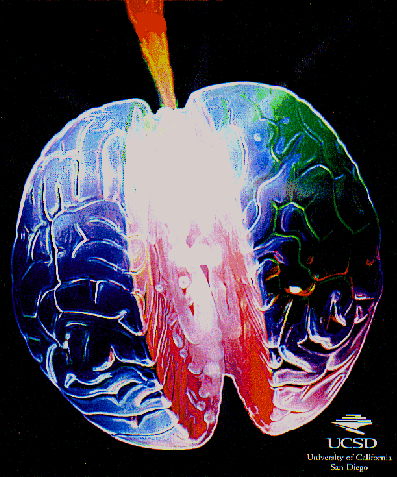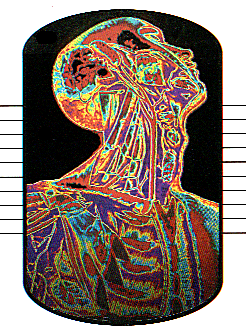


 |
 |
 |
On 06/18/96 the FDA announces approval of t-PA (Activase) for the treatment of acute ischemic stroke.

1996: t-PA has been cleared by the FDA for treatment of eligible adult patients with an acute ischemic stroke within three hours of symptom onset. UCSD (the University of San Diego Medical Center) and eight other centers around the country have brought the first drug to the American public for the treatment of stroke.
Per UCSD protocols; all stroke patients will be treated "code status"priority. Any patients that arrive in the ED within the first 24 hours of symptom onset should have a Stroke Code called. All appropriate patients who arrive within 3 hours of symptom onset will be evaluated for t-PA. Research indicates that less than 24% of stroke patients arrive at the E.D. within the 3 hour window form the onset of symptoms. Patients who are not appropriate for the treatment (fall out of the inclusion criteria) or arrive greater than 3 hours of onset will be evaluated for other research protocols. The risk of using t-PA is an increased chance of bleeding within the brain. In-services should be planned at your ED or department.
Results of the research was published in The New England Journal of Medicine, Dec. 1995. Copies of this article can be obtained from the UCSD Stroke Team @ (619) 543-7765. Contact Karen Rapp, RN.
We have changed the way stroke will be view from this time forward, NOW stroke is an EMERGENCY!
"Beyond the clear need for public education initiatives, the
currently available educational offerings and clinical approaches practiced in
emergency medical systems indicate that widespread re-education and
re-orientation of pre-hospital care services are now clearly in order if we
want to ensure the optimal management of patients with acute stroke"
Paul E.Pepe, M.D., M.P.H., F.A.C.E.P.,F.C.C.M., F.A.C.P.
Allegheny
University of Health Sciences, Allegheny General Hospital
Pittsburgh,
Pennsylvania

The Cost of Stroke
|
Risk Factors
|
Symptoms
|
| C.P.S.S.
Evaluation Additional M.E.N.D. Evaluation Assessments Miami Emergency Neurological Deficit Exam
|
Risk Factors
|
Preform the Cincinnati Pre-Hospital Stroke Scale If time permits, do the complete Stroke MEND evaluation.
Maintain an airway, straighten patients head Apply 2 - 4 L/min O2 via Nasal cannula. Only use high flow O2 via Mask if the Oxygen Saturation is diminished or hypoxia is expected.
Keep the patient from ingested anything by mouth. Elevate the patients head to at least 30 degrees If the patient vomits, turn them to the side and use suction, then return them to the semi fowlers position
Do not treat HIGH Blood Pressure
Establish an IV of Normal Saline (DO NOT use Dextrose Solutions. Treat Low Blood Glucose levels only if the value is less than 50 mg / dl.
|
Symptoms
|
|
|
|
|
|
CT Scan to confirm |
|
|
|
|
|

| Crossed signs: Weakness or numbness on one side
of the face and the opposite side of the body Diplopia: Double vision in which one image is seen at a higher level than the other. Dysarthria: Slowed or distorted speech caused by weakening of the tongue or other muscles essential to speech. Dysconjugate Gaze: Failure of both open to move together simultaneously. Dyphagia: Difficulty swallowing Gaze Palsy: Weakness of the eye muscles in which both eyes fixed to the side or midline. Hemiparesis: Partial weakness on one side of the body. Hemisensory Loss: Weakness or absence of sensation on one side of the body. Light Intolerance: Abnormal reaction to light when opening eyes: "photophobia." Neglect: A condition in which the patient does not acknowledge left sides body parts: may include denial of visual or tactile stimulation on the left: "Left Hemi-inattention." Quadriparesis: Partial weakness of all four limbs. Tinnitus: Ringing in the ears. Truncal / Gait Ataxia: Imbalance while walking; manifested by walking with a wide base. Vertigo: A sensation of movement that is not actually present; often described as a spinning sensation. |
With the recent recognition of the potential for reversing or limiting acute stroke through early interventions, patients with "brain attack" have now joined the ranks of those with acute myocardial infarction. and major trauma.
This indicates:
As in the case of the trauma patient, professional responders must promptly begin certain limited interventions and rapidly evacuate the stroke patient to a pre-alerted specialty center capable of providing definitive interventions. Also, as in the case of the a trauma center, experts must be available around the clock, ready to rapidly diagnose the stroke etiology and provide immediate intervention. Furthermore, those specialists must prepared to deal with the potential complications of their interventions and to evaluate the patient for predisposing or complicating conditions.
However, unlike the clinical scenario of bodily injury, the clinical presentation of stroke is often much more subtle. More importantly, the patient with acute stroke symptoms does not evoke the same level of anxiety or action as the patient with an abdominal gunshot wound. This relative lack of anxiety and responsiveness applies not only to the lay person witnessing the onset of symptoms, but also to the emergency medical personnel responsible for such patients. Such relatively cavalier reactions to stoke patients cannot be thought of as insensitivities or lack of concern on the part of those medical care providers. Their reactions simply reflect the general "state-of-the-art" in current medical education, particularly for emergency medical services (EMS) personnel.
Up until the present time, acute stroke has largely been considered an unfortunate medical problem requiring only supportive care and monitoring. In turn, with the exception of those experiencing loss of consciousness and or respiratory compromise, a sense of urgency regarding stroke stroke patients generally has not been conveyed in either the training of 911 dispatchers or the training of responding EMS personnel. Compounding the problem has been the evolution of managed care (primary care screening) as well as sophisticated priority dispatch systems (911 centers). Specifically, in some circumstances, dispatchers may purposefully triage and dispatch lesser trained personnel, using a non-emergent response mode (no lights and siren), when a non life threatening situation is not identified during the telephone in-take. In addition, few dispatch centers actually utilize triage algorithms that help to identify and in turn, prioritize patients with "brain attach." Likewise, the responding EMS personnel have not been routinely trained to identify stroke victims and take them directly (and rapidly) to specific centers capable of providing immediate diagnosis and intervention (as done in the case of trauma center triage and transportation).
Why is there a Time-Dependant Chain of Recovery for Stroke?
Prior to 1995, most of the medical community considered the management of stroke to be largely supportive care. The recently published study of t-PA for acute stroke management, sponsored by the National Institute of Neurological Disorders and Stroke (NINDS), as well as other studies, helped to re-orient the mentality of most practitioners toward the urgency of managing stroke.
But rapid evacuation to definitive care depends on having a series of sequential, interdepartmental factors in place in order to optimize the outcome for acute stroke patients. Just as the American Heart Association (AHA) has fostered the concept of a Chain of Survival for patients with cardiac arrest, a similar metaphor is also befitting for stroke patients. In the AHA model, the sequential., interdependent links include access (911 call); bystander CPR; early defibrillation; and early advanced life support. If one the links is missing in this time dependent situation, survival chances become bleak. A similar chain of survival has been described for trauma patients. In the case of stroke, a Chain of Recovery may be a more appropriate metaphor in that many untreated patients may survive, but do so with devastating neurological deficits that might have been reversed or ameliorated with earlier intervention. As in the case of cardiac arrest or trauma, it still takes a series of interdependent, sequential events during the emergency phase of care to make the chances of full recovery from stroke possible.
Paul E.Pepe, M.D., M.P.H., F.A.C.E.P.,F.C.C.M., F.A.C.P.
Allegheny
University of Health Sciences, Allegheny General Hospital
Pittsburgh,
Pennsylvania


Send E-Mail to:
The San Diego Paramedics.
Back toMedNews On-Line
To go back to; The San Diego Paramedics: Click here!
PLEASE NOTE:
Text and articles provided by the members of the San Diego Paramedics
and San Diego County Paramedic Association or related parties. This "News
Service" is an additional medium to the newsletters produced by Bob Morrison
for The San Diego Medic Association and Todd Klingensmith for The SDCPA.
All articles submitted are edited and proof read by the editor and subject to
ejection for poor subject matter. All articles are assumed to be free of
copyrights and plagiarisms. All articles sent will become property of this
medium and will not be used for profit or gain. We reserve the right to
disqualify any material deemed inappropriate. We are not responsible for lost
data or will we be responsible for returning anything unless directed by the
author. If an article is rejected, a message will be sent explaining the
rationale.
The San Diego Paramedics and The San Diego County Paramedic Association
does not necessarily support any opinion stated here and any such opinion is
the direct association of its author.
 |
 |
 |
 |
Web page design and maintenance by
Mitch Mendler
E.M.T. Paramedic FireFighter;The WebMaster!
Brief Disclaimer.